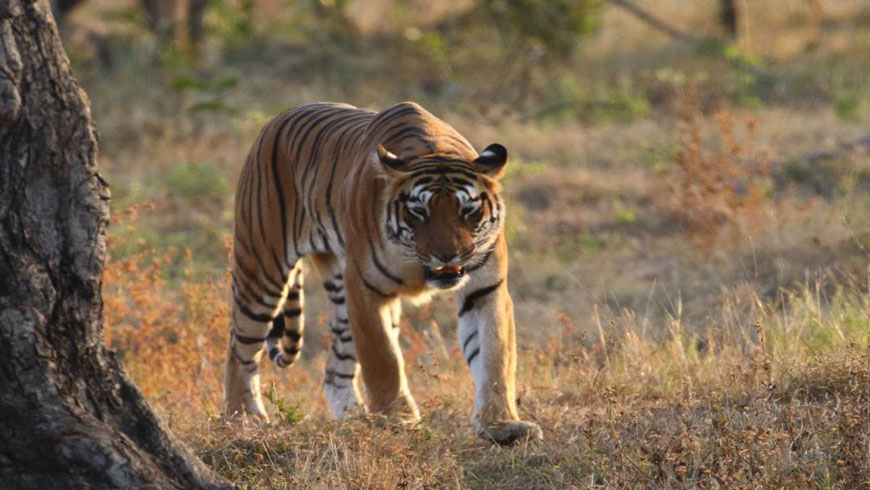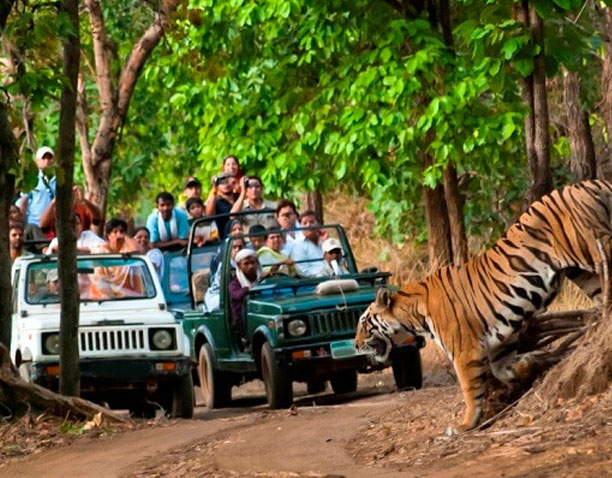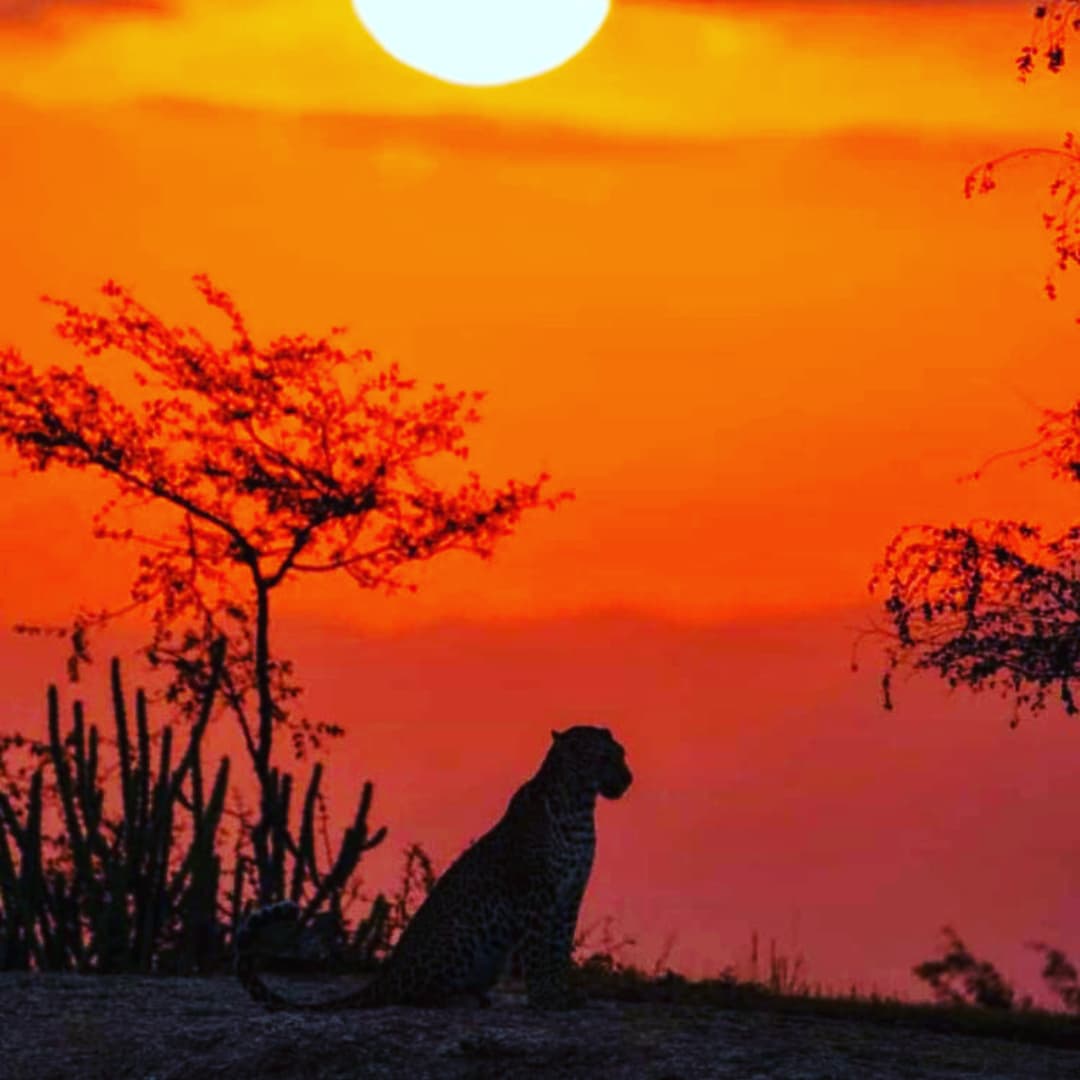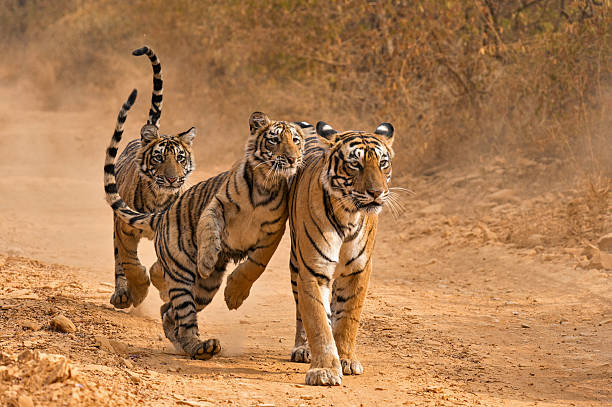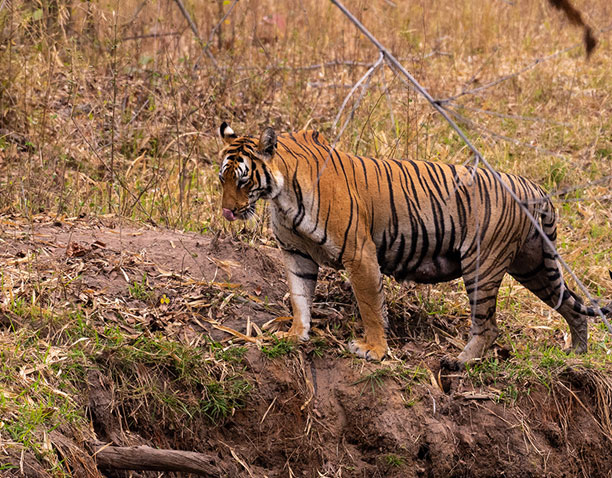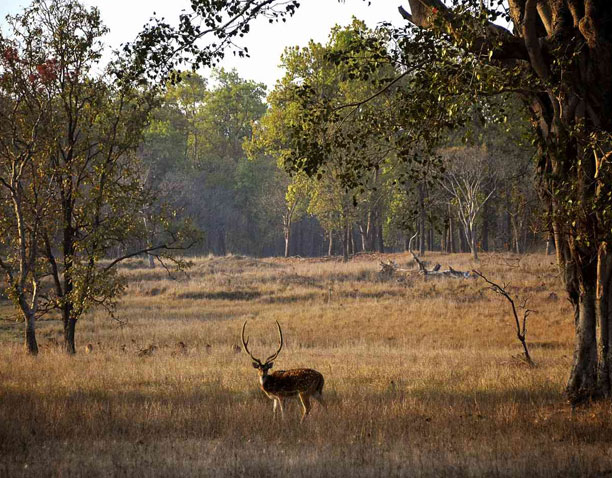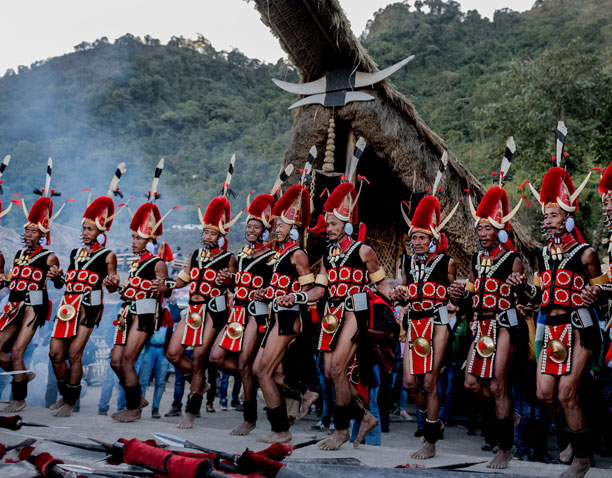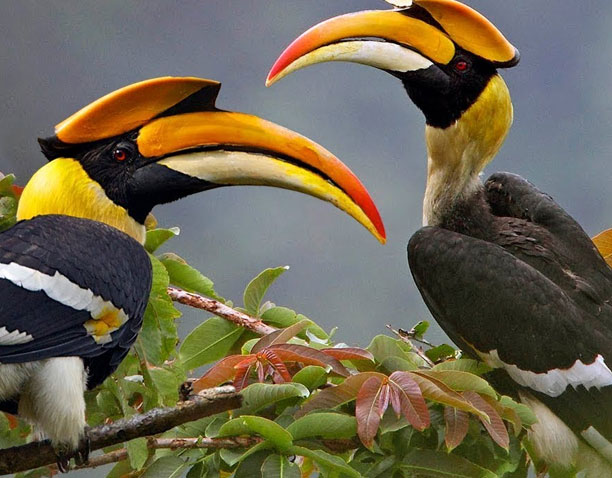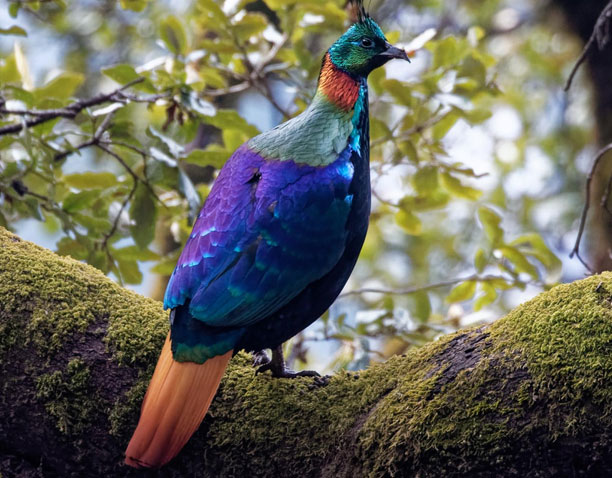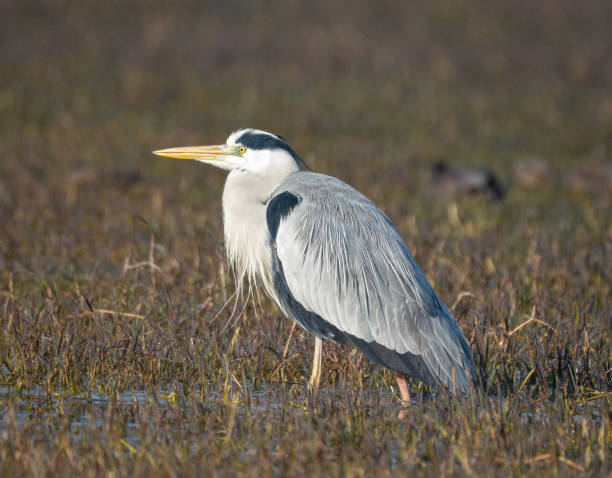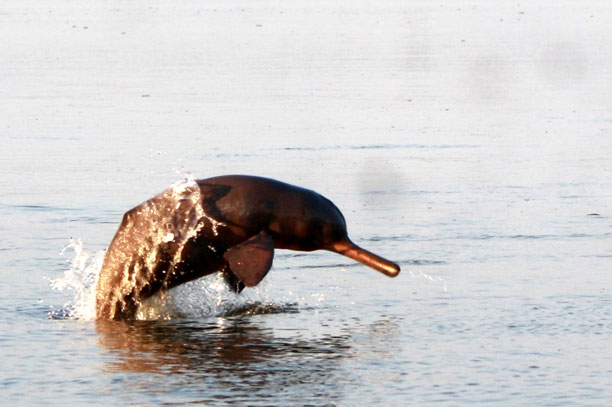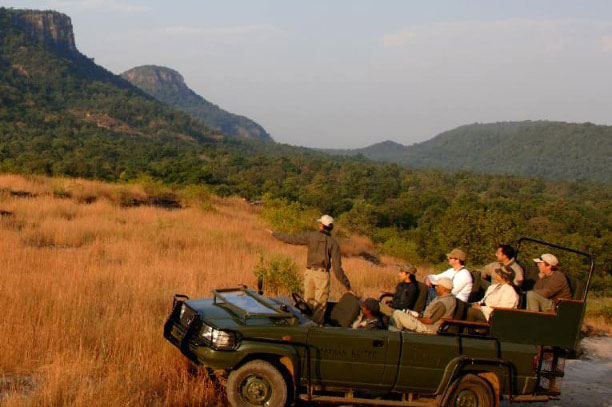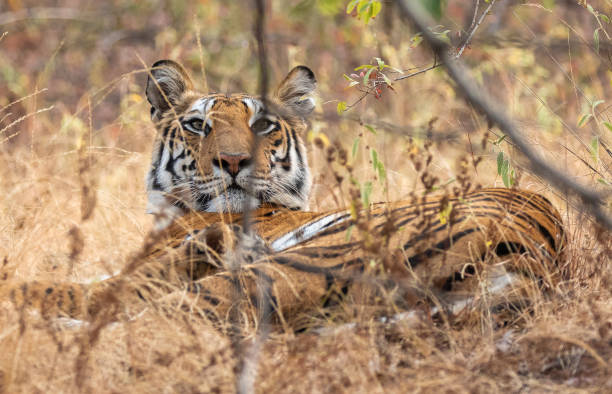A great time to go on a tiger safari in India is when the climate is optimal. The perfect conditions for an unforgettable experience are provided by CASTLE AND KING INDIA.
For wildlife aficionados and photographers, this blog post will offer guidance on the most suitable times and climates to undertake a tiger safari in India’s top national parks such as Ranthambore, Corbett, Kanha, and Bandhavgarh. If you are still searching for the ideal spot for tiger safari in India, read our blog post on the best places or parks for tiger safari in India.
- In Rajasthan, India lies the Ranthambore National Park
The majestic Royal Bengal Tiger can be spotted in the wild at Ranthambore National Park and Tiger Reserve, located in Rajasthan’s Sawai Madhopur district. This park is nestled among the Aravali and Vindhya mountain ranges, offering an exciting and memorable experience with its unspoiled wilderness and rare wildlife. Visitors can expect to have an unforgettable experience, possibly with an encounter of the Royal Bengal Tiger and other wild animals.
The Ranthambore National Park is spread over an area of 392 square kilometres, with 282 square kilometres forming the centre of the park and the remaining 110 square kilometres being its buffer zone.
In 1973, the Ranthambore Tiger Reserve was first founded, covering an area of around 334 sq km. This changed in 1991, when it was extended to include the Sawai Man Singh Sanctuary and Keladevi Sanctuary, bringing its total size to 1334 sq km. Two years later, the Ranthambore Tiger Reserve Forest was officially designated as a National Park; and in 1984, the Sawai Man Singh Sanctuary and Keladevi Sanctuary were added to the nearby forests. This region is known for its stunning historic sites and vibrant, exotic landscape.
Ranthambore’s Clime and Heat
Ranthambore exhibits a climate and temperature that is unique to its particular geographic location.
Ranthambore experiences three major weather seasons: summer, winter and monsoon. Starting from the last week of March until the last week of June, the summer season is hot with temperatures reaching up to 40 degrees Celsius during the day and around 30 degrees Celsius at night. May and June are especially hot, with temperatures occasionally reaching 45 degrees Celsius. During this season, tigers and other large predators usually make their home in the valleys, dense parts of the forest or near water bodies.
From the month of July to September, the monsoon appears after the end of the summer season. Consequently, the park is closed to visitors during these months.
November marks the beginning of winter and it carries on until February. Generally, the daylight temperature is about 20 degrees Celsius, yet when the last week of December and the first portion of January rolls around, the night temperature drops to 10 degrees Celsius or even lower to a mere 2 degrees Celsius.
Optimal period to tour Ranthambore
Beginning in early November and continuing until mid-April, the optimal period for tiger safari in Ranthambore is marked by pleasant weather and a hassle-free traveling experience. During this time, the lush vegetation of the forest and the aquatic flora of the lakes paint an exquisite backdrop.
- Corbett National Park, located in the state of Uttarakhand in India, is renowned for its wildlife and beauty.
Nainital District, situated in the Uttarakhand province, is the home of Corbett National Park, a part of the Corbett Tiger Reserve and a Project Tiger Reserve. Corbett National Park is India’s first and most well-known National Park, which was founded as Hailey National Park in 1936. Additionally, it is noted as the place where Project Tiger was launched in 1973.
This National Park, which allows visitors to stay overnight, covers an area of 520km2 and offers many different types of terrain, including hills, grasslands, riverine belts, marshy areas, and a sizable lake. Tourists can explore the park on an elephant’s back or in an open-wheeled Jeep and observe the local wildlife in their natural habitat.
Wildlife lovers often travel to this national park due to its abundance of tigers and its other animals, such as the otters and the fish-eating crocodile, which can only be found here.
Corbett National Park is divided into five unique zones, each with its own wildlife safari. Among these, the Dhikala Tiger Safari Zone is the most popular destination. Visitors can choose to explore any of the six areas: Bijrani, Jhirna, Dhela, Dhikala, Durga Devi, or Sitabani.
Corbett’s Clime and Temperature
The climate and temperature in Corbett can vary considerably depending on the season. During the summer months, the weather is quite hot and humid, while during the winter months, temperatures can be quite chilly. The average temperature across the year is between 16-20°C. Rainfall is abundant in the monsoon season and the winter months are usually dry.
Jim Corbett National Park features a temperature-controlled atmosphere with summers, winters, and monsoons just like the climate of the entire country.
From November to February, wild animals can be spotted in their natural habitat. Even though the days stay pleasant, the minimum temperature in the early hours and late evenings may dip to 5 degrees Celsius. Leopard sightings are more common in the higher elevations. All five gates of the national park are open.
In the period between April and mid-June, the locals anticipate the summer months. Although the temperature can reach a scorching 42 degrees Celsius, one can still observe some of the wildlife in the park, though even they cannot bear the heat for long.
The Jhirna zone of Jim Corbett is the only area open during the monsoon season, ideal for those looking for a calmer atmosphere and a lush environment. However, it is not recommended to visit during this time frame. The monsoon season for this part of the world starts in June and concludes in September, and there is a high risk of landslides and soil erosion.
The optimal period to tour Corbett
Visiting Corbett National Park is best done between November and March due to the favorable weather during this time frame. During this period, it is an ideal season for viewing tigers and bird watching. The park is open for business from the 15th of November to the 15th of June. However, during the monsoon season, commencing from the middle of June, entry to the park is restricted. To observe wildlife, visitors can opt for an elephant ride or a jungle safari.
Bandhavgarh National Park, situated in Madhya Pradesh of India, is a sight to behold.
Bandhavgarh National Park, located in India, is renowned for its high concentration of Bengal tigers. The park is 1536 sq km in size, consisting of both core and buffer zones, and is an ideal destination for wildlife enthusiasts, photographers, and filmmakers. In addition to tigers and leopards, the habitat is also home to many other animals, such as elephants, sloth bears, deer, jackals, wild boar, langurs, and macaques. It is also known to be a bird-watching paradise, as records show there are over 250 species of birds, 80 species of butterflies, and 37 species of wildlife in India located within the park.
The Vindhya highlands of Umaria district in Madhya Pradesh host the Bandhavgarh area. It was declared a national park in 1968 and nowadays it is a highly sought-after destination for Tiger Safaris in India, where visitors can take photographs and follow the tigers in their natural habitat.
Bandhavgarh has six zones dedicated to tiger and wildlife safari experiences. Of these six, Tala, Magdhi, and Khitauli are the primary areas while Dhamokhar, Johila, and Panpatha are considered buffers.
The climate and temperature of Bandhavgarh
At Bandhavgarh the climate and temperature are both warm and temperate. Summers are warm with temperatures ranging from 28 to 42 degrees Celsius, while winters are cold with temperatures ranging from 10 to 22 degrees Celsius. The average temperature throughout the year is around 25 degrees Celsius.
The two distinct seasons of the Bandhavgarh National Park are summer and winter. The heat can reach its peak of 44 C in May or June, and the monsoon season can start as unexpectedly as mid-June. The winter season begins from mid-November to February’s end; visitors should come prepared with many layers of clothing to protect against the frigid temperatures. Frost may form in the marshy hollows if the temperature drops to 2 C. It is also recommended to wear extra warm clothing due to the additional cooling effect of the wind when riding in the park’s open vehicles.
The optimum time to make a journey to Bandhavgarh is
The right time to go on a tiger safari in Bandhavgarh National Park is dependent on the purpose of the visit. October to January is the most suitable period to view a variety of bird species in their lush habitat, since it is the season many of them migrate. April, May and June are renowned for being the prime months for tiger and wildlife photography. During this time, the heat causes animals to stay close to water sources; thus, giving visitors the opportunity to take uncommon tiger pictures. It is best to avoid a safari during the hottest time of the year.
- The Kanha National Park, located in Madhya Pradesh, India, is a protected area renowned for its wildlife and natural environment.
The Maikal range in the state of Madhya Pradesh, which makes up the central Indian highlands, is where the Kanha National Park is located. It is interesting to note that this park has been given the title of Tiger Reserve and is being renowned worldwide as one of the best wildlife sanctuaries. The Kanha National Park, which encompasses two separate districts, Mandala and Kalaghat, was initially categorized as a reserve forest in 1879, and then in 1933, it was upgraded to wildlife sanctuary. Finally, in 1955, it was promoted to a national park.
Kanha National Park covers an area of 940 square kilometers, situated within the Maikal series of hills. The size of the entire Kanha Tiger Reserve, including both the core zone and buffer zone, is estimated to be 1945 square kilometers.
Kanha National Park is a remarkable reserve, teeming with a profusion of wildlife, including the majestic tigers and the Barasingha, which are the most prevalent. The area is also abounding in diverse vegetation, birds, reptiles, and insects. It has become increasingly popular among tourists from around the world due to its facilities which have been specially designed for them. The Bammi Dadar, or Sunset Point, is the perfect place to truly appreciate the beauty of this sanctuary.
Temperature and Climate at Kanha
The climate in Kanha is typically hot, with temperatures ranging from mild to extreme. The hottest months are usually April and May, while the mildest months are December and January. Rainfall is scattered throughout the year but mainly during the monsoon season which runs from June through September.
The best months for a tiger safari at Kanha National Park are between October and June. During this period, the climate is perfect. Between April and June, however, the temperatures can rise to a scorching 43°C. The rainy season is from the middle of June to September, and the average precipitation is 1,800mm.
Starting in November and extending through February, the winter season is experienced in Kanha. Temperatures can drop to a point where frost lines the meadows, so to enable visitors to plan their trip accordingly, the climate of Kanha National Park is described in further detail.
Optimal period for a trip to Kanha
Kanha National Park in Madhya Pradesh is home to a wide selection of wildlife. Tourists and photographers can access the park from October 16th to June 30th each year. The best time to go is from March to June, as it is the easiest time to observe the different types of birds and other animals.
Pench National Park & Tiger Reserve, located in Madhya Pradesh, is a popular tourist destination.
The Pench National Park, set in the state of Madhya Pradesh (the heart of India), has a total area of 758 square kilometers, with the majority of it situated in the districts of Seoni and Chhindwara. An additional 257 square kilometers of the park is in Maharashtra. This park is split into two sections: the Priyadarshini National Park and Mowgli Pench Sanctuary, which take up 299 square kilometers of the area, and the buffer zone of 464 square kilometers. It is called Pench after the river that runs through it, dividing it almost equally into eastern and western parts.
In 1965, the Pench area was made a sanctuary, and 10 years later it was declared a national park. It has a high concentration of tigers, and so in 1992 it was named a tiger reserve and included in Project Tiger. Rudyard Kipling’s renowned work “The Jungle Book” also mentions the striking beauty of the area.
Climate and Temperature of Pench
The climate of Pench is hot and dry. The temperature in the area varies greatly, ranging from very hot in the summer months to quite cold in the winter.
The months between April and June in Pench national park are unbearably hot with temperatures ranging from 25C to 50C. This is the best time to witness the most tigers in the park. During July and August, the park receives an average of 1300 millimeters of precipitation so it is closed off. The monsoon brings a refreshing atmosphere and revitalizes the vegetation in the area. The winter season in Pench starts in November and ends in February. The temperatures are much cooler and range from 6C to 31C. This period is great for observing wildlife in Pench national park.
Ideal Occasion for a Trip to Pench
Visiting Pench at the best possible time can make for a great experience.
Exploring Pench is best between October and February as the weather is mild and the jungle is lush. Birdwatchers should take note that November and March are particularly great months to visit, as these are when birds migrate from colder regions to Central India for the winter. Additionally, during this time, fawns can be seen.
- Madhya Pradesh’s Panna National Park
Panna National Park, situated in Madhya Pradesh, is an important natural site. It is known for its rich flora and fauna and is a popular tourist destination.
Shreenivasa Murthy, a forest officer in the region, and his staff have worked to make Panna National Park the best-managed and -maintained national park in India. This 542.67-square-kilometer park located along the Ken River in the central Indian state of Madhya Pradesh has earned the 2007 Award of Excellence and is the 22nd tiger reserve in India and the fifth in Madhya Pradesh. The UNESCO World Heritage Site of Khajuraho is 57 kilometers away from the Panna Reserve. Thanks to the efforts of the staff, Panna Park is now the best-developed and -maintained national park in the region.
As it winds its way to the valley, Ken River creates a number of stunning waterfalls. Furthermore, Panna National Park has several sites of historical importance which contain Neolithic-era rock art. The reserve is a home to a plethora of animals such as Indian tigers, Indian wolves, four-horned antelope, sloth bears, pangolins, rusty-spotted cats, leopards, caracal, and gharial, due to its deciduous forest environment.
The climate and temperature of Panna
The climate and temperature of Panna are two important factors to consider when visiting this area. The climate is generally hot and humid, with temperatures ranging from the mid-90s Fahrenheit in the summer months to the mid-50s Fahrenheit in the winter months. Precipitation is common throughout the year, but the heaviest rainfall occurs from July to September. The temperature in Panna can also be quite extreme at times, with temperatures reaching up to 115 degrees Fahrenheit in the summer and dropping as low as 32 degrees Fahrenheit in the winter. It is important to be prepared for the wide range of temperatures when visiting Panna.
The Panna National Park features a tropical climate, resulting in varying weather patterns for each of the seasons. During summer, temperatures soar, making it an unpleasant time to visit the park. The monsoon season coincides with the wild animals’ breeding season, yet winter is the ideal time to explore the park due to its cool and pleasant climate.
Starting from March, the summer season at Panna National Park brings with it extremely hot and humid conditions, making it difficult and uncomfortable for tourists to enjoy the park. However, the best time to visit is in winter, when the weather is mild, tranquil, and beautiful, allowing people to make the most of their stay. During the monsoon, the park is closed to visitors as this is also the breeding season for wild animals.
Ideal Moment to Journey to Panna
From November to May is the prime season to visit Panna. The sweltering heat of the summer season, with temperatures soaring to 45 degrees Celsius, makes it an unappealing time to take a vacation. Winters are more bearable than summers, but the best month to witness the wildlife in Panna National Park is March.
The impact of technology on society has been considerable and far-reaching. Technological advances have had a considerable influence on our way of life, from the way we communicate to the way we go about our daily lives. It has changed the way we interact with one another, and has impacted our education, our healthcare, the economy, and even our culture. There is no doubt that technology has made a significant impact on how we live.

